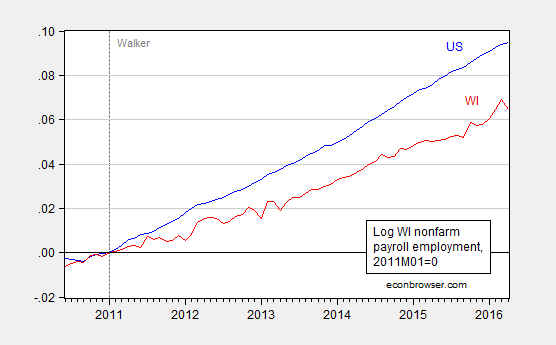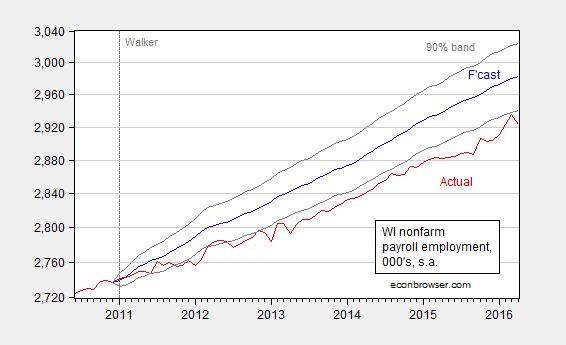Wisconsin’s Department of Workforce Development released employment figures today. Nonfarm payroll employment down 12,000, private NFP down 11,000, month-on-month.
Figure 1 depicts US and Wisconsin (log) NFP employment normalized to 2011M01; Figure 2 shows the counterfactual of what Wisconsin employment should be, based on historical correlations holding over the 1990-2010 period (using a ECM with national employment).
Figure 1: Log nonfarm payroll employment, 2011M01=0, for Wisconsin (red), and US (blue). Source: BLS, DWD, and author’s calculations.
Figure 2: Actual Wisconsin nonfarm payroll employment (red) and counterfactual forecast (blue), and 90% confidence band (gray). Source: BEA, DWD, author’s calculations. Counterfactual forecast from ECM using US, Wisconsin NFP, one lag of first differences, estimated 1990-2010, assumes US NFP weakly exogenous (see description here).
To sum up: Wisconsin NFP employment is declining, and is trending at a pace lagging the national rate, and is currently at a level statistically significantly different from that implied by historical correlations. Using a sample ending in 2009M06 instead of 2010M12 does not materially change these conclusions, as noted in this post.
John Koskinen, Chief Economist and Division Administrator for the Division for Research and Policy Analysis, in the Wisconsin Department of Revenue from 2007-15, had a more upbeat view, which is discussed here. He characterized Wisconsin employment growth as pretty good, although it was not clear to me what statistical benchmark he used. A more downbeat assessment is here.


1. It appears that most of the reason that unemployment levels are declining is emigration out the state.
2. Although it is tempting to give Walker and the Republican legislature and his plutocratic patrons the blame for Wisconsin’s lackluster economic performance the last two years, it is likely that as a state more dependent then most on industry, agriculture, and natural resource extraction (mining and logging) it has been hurt by the global macroeconomic trends of the last two years (a strong dollar hurting exports and helping imports and a global commodity slump).
3. The dismantling of the Wisconsin University System for political reasons (another “liberal” power base to be liquidated on the road to making Wisconsin Galt Gulch) is probably the opposite strategy to what should be done create substitute areas of growth in Educational and Medical services and to make Wisconsin an attractive destination for young, creative people.
sherparick: 1. Emigration and low population growt have been long term phenomenon, captured in the co integrating relation (that is why the long run elasticity of WI to US is about 0.6 and not unity).
2. I tried to incorporate dollar strength by including it in the co integrating vector; it doesn’t help explain the shortfall.
I’m curious as to how government employment data would impact this result. Have you tried that approach as well? In other words, is the result due to a slower private sector or slower government sector, or both?
Pete Bias: yes, in the past, using private NFP, one obtains similar results.
I would’ve expected faster U.S. employment growth to catch-up with Wisconsin’s low unemployment rate and high labor force participation rate or slower Wisconsin employment growth closer to full employment. Also, we’ve had a slow global expansion, particularly compared to the fast global expansion in the 2000s.
I think, Wisconsin needs more high-skilled jobs, not necessarily in health care, where the cost of output is too high. Wisconsin may not be in a position to attract many high-skilled jobs from other states. It needs to spur a virtuous cycle of creating and attracting high-skilled jobs, which will shore-up the rest of its economy.
I’ve noticed that many legislators that are running for re-election are touting the last few month’s jobs reports from February to March as vindication for their policies that Wisconsin is now seeing positive results more than five years into the Walker administration.
http://www.jsonline.com/news/opinion/gov-scott-walker-the-wisconsin-comeback-continues-b99720081z1-378539115.html
Although”… the three-month run of job growth was halted in April by the largest one-month loss in jobs in nearly seven years. The state lost 11,500 private-sector jobs in April, 0.5 percent of the workforce, according to preliminary, seasonally adjusted estimates by the Bureau of Labor Statistics. If the figures stand up to revisions, it will be the state’s biggest monthly jobs drop since July 2009, during the Great Recession.”
http://host.madison.com/ct/business/wisconsin-s-string-of-monthly-job-growth-abruptly-halted-in/article_9edf3bec-2f4f-53ea-80d1-f654b2b88ba9.html
Has anything changed in the last two years on this score? I see that the coincident activity index for Wisconsin has expanded at an annual rate of 3.43% over the last 24 months compared to 3.17% for Minnesota. Is there a reason why Wisconsin has been growing faster than Minnesota?